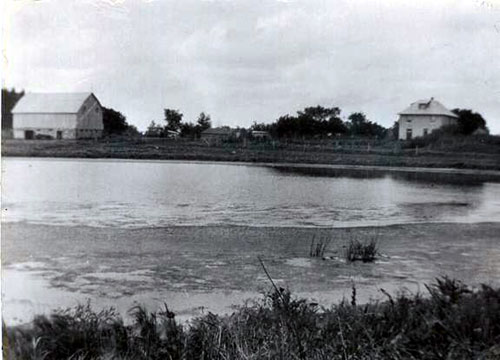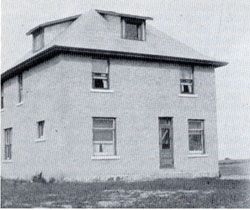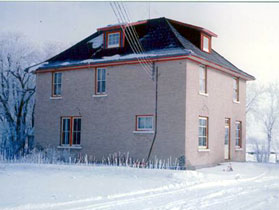| Home | Scotland | England | Canada | Cameron Family Tree | Comments/Contact |

Elaine
M. McCrorie
Regina,
Sask., Canada
|
Cameron Farmyard As the snow melted and the ground warmed, preparation for spring seeding began with the cleaning and treating of the grain. Toward the end of May and early June the grain (wheat, oats and barley) were planted. We have to remember that this was done with a team of eight horses, which had to be fed and cared for. The vegetable garden was planted. These were long days on the farm, but exciting as a new season began. After the grain was sown there was a short period of rest before it was time to mow the hay, gather it and store it for the next winter. This usually took place in July. Soon it would be time to start the harvest. The grain was cut and bound into sheaves. The sheaves were stooked and left to dry. Then, one day the threshing machine and crew would arrive to thresh the grain. This was a particularly busy time, not only for the men in the field, but also for the women. They had to provide meals, for up to twenty men, three times a day and lunches at mid-morning and mid-afternoon. They also continued to do the daily chores – washing, ironing, mending, cleaning, butter-making and cheese-making. The garden produce would be ready for harvesting at this time, so there was the work of canning the vegetables from the garden. Wild berries (saskatoons, chokecherries, pincherries, and blackberries) were ripening on the bushes. These were picked and preserved as fruit or jam. The grain was stored in granaries on the farm. During the late autumn some of the grain would be hauled to market. The land was ploughed, in preparation for the next year. To prepare for winter the wood was piled near the house, the cistern was filled with water, and straw from the grain was stacked to be used as bedding for the animals. Soon the ground would freeze and be covered with snow. It was a quieter time. There was time to visit neighbors and prepare for Christmas and a new year. Cameron Home In 1916 a new house was built on the farm. It was a large cream-colored brick house. It had large spacious rooms on the main floor – a parlor, living room, kitchen, pantry, washroom, and den. On the second floor there were four bedrooms with large walk-in closets and a bathroom. The third floor was an attic, which was never completely finished. The woodwork throughout the house was B.C. Fir. The brick probably came from the brick factory at Brookdale. There is a family story about the house. The story goes that one day as Hector was returning from school he picked up the mail. On the way home he got out of the van to run for a while. Upon arriving home he found that he had lost a letter. He went back to where he had gotten out of the van and he found the letter. It contained a cheque, which was his mother’s share of her mother’s estate. That money was used to build the house. While they worked hard on the farm there was time for community involvement. The Manitoba Wheat Pool was organized in 1923-24, the United Farmers of Canada, Manitoba Section was active, and Community Clubs were formed to organize picnics, concerts and dances. Andrew sold the farm to Hector in 1929. Andrew and Martha continued to live on the farm until their death. Martha died on Feb. 26, 1929 at 67 years of age. Andrew died on April 5, 1935 at 78 years of age. |
Note: All images on this site are property of Elaine M. McCrorie and may not be reproduced in any way without prior consent

Our thanks to Elaine
McCrorie for her hard
work and dedication in
the making of the
Manitoba Camerons.
The Camerons in Canada

Compiled by
Elaine McCrorie


